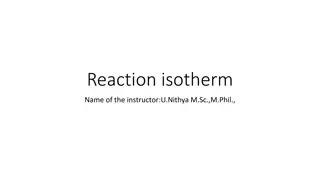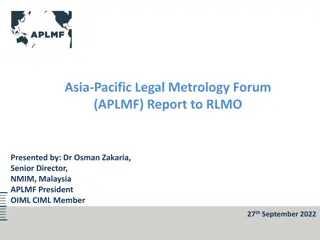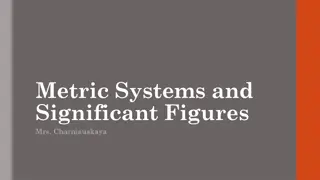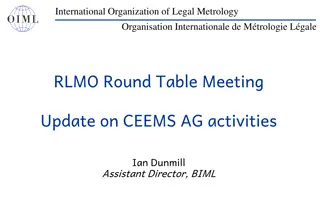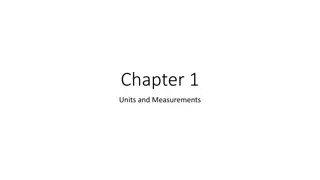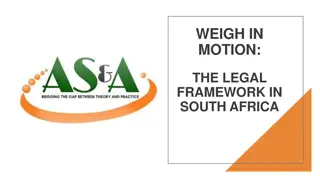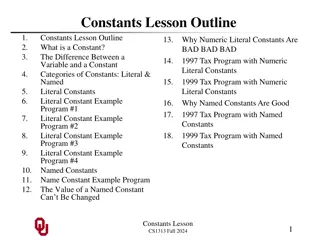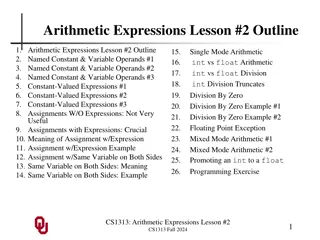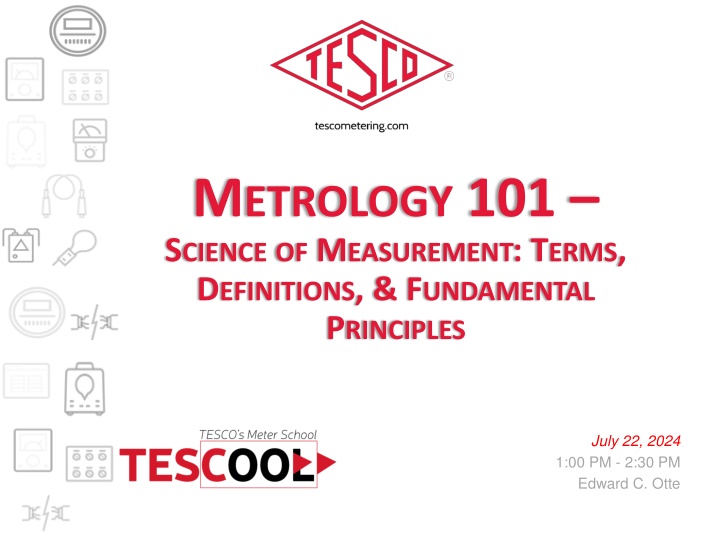
Fundamental Principles of Metrology: Units, Derived Units, and Constants
In this discussion, delve into the world of metrology focusing on base SI units, derived units, common SI measurements, and fundamental constants. Explore the significance of measurements in fields such as electrical metrology and understand the role of physical forces in establishing units of measurement. Gain insights into key concepts like time, temperature, electrical current, and more.
Download Presentation

Please find below an Image/Link to download the presentation.
The content on the website is provided AS IS for your information and personal use only. It may not be sold, licensed, or shared on other websites without obtaining consent from the author. If you encounter any issues during the download, it is possible that the publisher has removed the file from their server.
You are allowed to download the files provided on this website for personal or commercial use, subject to the condition that they are used lawfully. All files are the property of their respective owners.
The content on the website is provided AS IS for your information and personal use only. It may not be sold, licensed, or shared on other websites without obtaining consent from the author.
E N D
Presentation Transcript
METROLOGY 101 SCIENCE OF MEASUREMENT: TERMS, DEFINITIONS, & FUNDAMENTAL PRINCIPLES July 22, 2024 1:00 PM - 2:30 PM Edward C. Otte
BASE SI UNITS In general, ISO systems (ex. 9001 & 17025) follow European units of measurement, the metric system, SI stands for International Standards, From the point of view of electrical metrology, we are concerned directly about: Time (measured in seconds) Electrical Current (measured in Amperes) Thermodynamic Temperature (measured in Kelvins) Indirectly we also consider: Length (measured in meters) Mass (measured in Kilograms)
SI DERIVED UNITS From SI Base Units there are several Derived Units such as: Energy/ Quantity of Work (measured in Joules, J) Power/ Heat Flow Rate (measured in Watts, W) Frequency (measured in Hertz, Hz) Magnetic Flux (measured in Webers, W) Inductance (measured in Henrys, H) Electrical Charge (measured in Coulombs, C) Capacitance (measured in Farads, F) Voltage (Measured in Volts, V) Resistance (measured in Ohms, ) Temperature (measured in Celsius Degrees, C ) From the above take note Power is not P, Inductance and Current is not I, Resistance is not R, and we do not use Fahrenheit Example 1 amp, is equal (6,250,000,000,000,000,000 electrons) passing by a given point in a circuit during 1 second of time to 1 coulomb of
COMMON SI MEASUREMENTS Beyond Electrical Metrology, there are seven common measurements: Temperature Humidity Pressure Torque Force Mass Voltage/ Current/ Resistance Time/ Frequency Linear Displacement
FUNDAMENTAL CONSTANTS As of 2019 a new system method of establishing units of measurement using physical forces such as the speed of light, gravity, or universal gas constants was agreed upon, see partial list below. Measure Constant Atomic Mass mu Avogadro constant NA, L k Boltzman constant conductance quantum GO electric constant O electron mass me eV electron volt elementary charge e Faraday constant F fine structure constant inverse fine structure constant -1 magnetic constant O magnetic flux quantum O R molar or universal gas constant Newtonian constant of gravitation G Planck constant h Planck constant over 2 pi proton mass mp proton-electron mass ratio mp/me Ryberg constant R c speed of light in a vacuum Stefan-Boltzman constant
Traceability Standards & Hierarchy Traceable is defined as the property of a result of a measurement or the value of a standard whereby it can be related to stated references, usually national or international standards, through an unbroken chain of comparisons all having stated uncertainties." According to the internationally recognized VIM (International Vocabulary of Metrology) definition, traceability is a property of the result of a measurement or the value of a standard by which that result or value is related to standards, notto institutions. Accordingly, the phrase "traceable to NIST", in its most proper sense, is shorthand for "results of measurements that are traceable to reference standards developed and maintained by NIST. Ultimately NIST traces back to SI as do all other national institutes.
THE TRACEABILITY PYRAMID Each step of the pyramid is made traceable by comparing with the level above it. Example, primary reference standards calibrate primary standards, which in turn calibrate secondary standards, but primary reference standards compare to national institute standards.
MEASUREMENT UNCERTAINTY All measurements have an unknown amount of deviation from the actual value known as the error or uncertainty ISO 10012-1, the metrology standard that is part of ISO 9000, recommends that the uncertainty resulting from the calibration process should contribute no more than one- third and preferably less than one-tenth of the total measurement uncertainty. (Most labs look for much lower.) ISO/IEC 17025 does not specify a value for the test uncertainty ratio (TUR) but requires a statement (shown below) as to the uncertainty. (Z540.1 was at least 4:1.) "5.10.4.2 ... When statements of compliance are made, the uncertainty of measurement shall be taken into account."
MEASUREMENT STANDARD A standard is a device or signal used as the comparison reference for a measurement. A standard is used to measure or calibrate other devices. The following is a basic list of types of standards: Primary Standard, Reference Standard, Working Standard, Intrinsic Standard, Derived Standard, Consensus Standard, Transfer Standard,
PRIMARY STANDARD A primary standard is one that is designated or widely acknowledged as having the highest metrological qualities and whose value is accepted without reference to other standards of the same quantity. The term primary standard is also commonly used, at least in a local sense, to refer to the best standard available at a given laboratory or facility An example of a primary standard is our P-5000, which is directly compared to national standards in NRC and is universally accepted in the utility industry as a golden standard.
REFERENCE STANDARD A reference standard is a standard, generally of the highest metrological quality available at a given location, from which measurements made at that location are derived. (NIST HB 150) A working standard is a standard that is usually calibrated against a reference standard and is used routinely to calibrate or check material measures, measuring instruments, or reference materials. (NIST HB 150) An example of a working standard may be a set of gage blocks calibrated against a higher accuracy set and then used to calibrate micrometers.
INTRINSIC STANDARDS Intrinsic Standards are based on well-characterized laws of physics, fundamental constants, or invariant properties of materials, and they make ideal stable, precise, and accurate measurement standards if properly designed, characterized, monitored and maintained. An example of an intrinsic standard is the cesium oscillator (considered an intrinsic time/frequency standard) because the SI definition of the second is based on a physical property of cesium. operated,
DERIVED STANDARDS A Derived Standard is a standard for which no direct artifact is available or is needed and whose value is determined through one or more of the following: a measurement of one or more well-known traceable quantities, a standard that can be established through the ratio technique, a standard that can be established through the reciprocity technique,
CONSENSUS STANDARDS Some definitions from the National Conference of Standards Laboratories for the consensus standard include: A measurement standard or process that is used as a de facto standard by agreement when no legal national laboratory standard is available. [NCSLI RP-2] Same as reference [standards] but [consensus standards] are used to simulate a stable UUT [unit under test] to establish the stability, measurement integrity/ assurance of a measurement or calibration process. [NCSLI RP-3] Same as reference [standards] but used as a de facto measurement standard by agreement when no national standard is available. [NCSLI RP-3]
TRANSFER STANDARDS Same as reference [standard] but used to transfer a measurement parameter from one organization to another for traceability purposes. [NCSLI RP-3] Any standard that is used to inter-compare a measurement process at one location or level with that at another location or level. [NBS SP 676-1] Standard used as an intermediary to compare standards. NOTE: The term transfer device should be used when the intermediary is not a standard. [VIM, 1993, Par. 6.8] As you can see from the definitions of standards, there is some overlap. For example, a transfer standard may also be called a reference standard, a primary standard may be called a reference standard, etc. The usage of terms often depends upon the level where the standard resides.
INTERPRETING SPECIFICATIONSAND TUR First, the Metrologist must understand how to interpret the specifications of both the "procedure specified" standard and the standard to be substituted. This is not always a trivial task as different manufacturer's report specifications in more than one manner. Second, the Metrologist must understand the effect of the substitution on the actual measurement including Test Uncertainty Ratios (TUR) for both instruments. Any substitution requires an understanding of measurement factors including basic equipment accuracies, equipment connections and loading, environmental factors such as temperature and humidity, equipment operation, drift, line voltage effects, and uncertainty ratios. When in doubt always consult the Laboratory Manager or the Laboratory Calibration Engineer. resolution, precision,
MEASUREMENT SYSTEMS MEASUREMENT METHODS There are six basic Measurement Methods: direct measurements differential measurements transfer measurements ratio measurements indirect measurements substitution measurements
DIRECT MEASUREMENTS Placing an instrument directly into contact with the unit under test makes direct measurements. For example, a handheld DMM with its leads placed directly into an electrical outlet will measure the line voltage directly.
DIFFERENTIAL MEASUREMENTS Using an instrument, such as a galvanometer or null detector, we can make differential measurements. The difference between a known and unknown quantity are measured. Using the same example test voltage, a differential reading is taken using a 10V standard. This time, the result has better resolution because Millivolts are being measured.
TRANSFER MEASUREMENTS In contrast, it is possible to make transfer measurements where the result of the measurement is not in the same units as the value that's measured. In this diagram, a resistor (Rtest) is being measured against a standard resistor (Rstd).
RATIO MEASUREMENTS Because the value of Rstdis transferred to Rtestvia the voltage ration, this is also a ratio measurement. Ratio measurements are very common in DC and low frequency metrology. Because there are no ratio standards, the evaluation of a ratio device is an independent experiment.
INDIRECT MEASUREMENTS Indirect measurements find the value in question from other values. For example, DC current is indirectly determined by measuring the voltage drop across a known resistance. The value of the current is computed from Ohm's law. Another type of indirect method uses a thermal sensor to compare the heat generated in a pure resistor by the alternate application of known DC and test AC voltages. If a perfect sensor is used, the AC and DC voltages are equal when the heat generated in the resistor does not change as they are alternately applied. This is also a transfer measurement, since the known value of the DC voltage is transferred to the unknown AC voltage.
SUBSTITUTION MEASUREMENTS The substitution method as the name implies, substitutes a standard value in place of the actual standard. One example would be the use of an electrical quantity for an actual physical quantity to calibrate a device. A calibrated signal generator may be used to simulate an actual sensor output (representing a physical quantity) as a calibration source for the system's readout device.
MEASUREMENT CHARACTERISTICS There are several common measurement characteristics that can be applied to electrical, physical, and dimensional metrological measurements, some are related, some are interchangeable: variability sensitivity repeatability reproducibility bias linearity stability precision
VARIABILITY Variability is the tendency of the measurement process to produce slightly different measurements on the same test item, where conditions of measurement are either stable or vary over time, temperature, operators, etc. and considers tow main sources: Short-term variability ascribed to the precision of the instrument, ex. below Long-term variability related to changes in environment and handling techniques, ex. below
SENSITIVITY The sensitivity of an instrument refers to how well the instrument perceives the parameter to be measured. It is the smallest change on the input that causes an indication on the output of the instrument. Another way to define the sensitivity is a measure of the minimum input signal to which a device will show a measurable response at the output. Example a digit of accuracy
REPEATABILITY Another definition for repeatability is the closeness of the agreement between the results of successive measurements of the same measurand carried out under the same conditions of measurement. Repeatability is the variation in measurements obtained with one measurement instrument when used several times by an operator while measuring the identical characteristic on the same part. Repeatability conditions are given in document ISO 5725 as shown here: "Repeatability conditions" - where independent test results are obtained with the same method on identical test items in the same laboratory by the same operator using the same equipment within short intervals of time.
REPEATABILITY EXAMPLE Repeatability is one of the R's in Gage R&R studies. Conditions shown in the graphic at below are for one operator at one machine measuring the same part. The width of the resulting bell curve provides an indication of the repeatability.
REPRODUCIBILITY Reproducibility conditions are where test results are obtained with the same method on identical test items in different laboratories with different operators using different equipment. Reproducibility is another one of the R's in Gage R&R studies. The graphic shows the differences between operators or different measurement systems. This characteristic is a measurement of the variation in the measurement "central tendencies" of each operator.
BIAS As defined in ISO 5725, bias is the difference between the expectation of the test results and an accepted reference value. The error of the result of a measurement may often be considered as arising from a number of random and systematic effects that contribute individual components of error to the error of the result. Although the term bias is often used as a synonym for the term systematic error, because systematic error is defined in a broadly applicable way, bias is defined only in connection with a measuring instrument, therefore the use of the term systematic error is recommended.
LINEARITY Most measuring instruments are designed to give a linear indication. This means that a graph comparing the actual values of a range of measurands to the readings of those values by the instrument will be a straight line. Some measurements, for example electronic amplification, are usually made on a logarithmic scale rather than a linear one.
STABILITY Stability refers to the ability of a measuring instrument to maintain constant metrological characteristics with time. In many case we check our standards with a daily operational verification and collect data to verify, among other things, proper stability before and after a series of measurements.
MEASUREMENT DATA CONSIDERATIONS - Measurement data is the media used to communicate measurements from the calibration lab to the equipment end user. Measurements can be made to the highest possible accuracies with measurement uncertainties approaching 0%, however, poorly recorded data nullifies the measurements as far as the end user is concerned. Data must contain the correct number of decimal places and clearly indicate the units of measurements. Data can be presented in a number of ways such as calibration reports, histograms, charts, diagrams etc.
IDENTIFYING MEASUREMENT DATA CONSIDERATIONS There are about six major focuses in the identification and how to respond to various measurement data considerations: Readability legible if handwritten, understandable, well labeled, integrity, - both the operator and equipment, quality assured, properly manipulated, Confidentiality customer focused, protected whether on a network or hard or soft copies, firewalls, passwords, etc. Resolution - the smallest possible difference between separate values of the output , assumed half digit, (mostly for caluculating uncertainly budgets,) Format how data is saved and presented, will format be dated and unusable in the future? Ex. Spreadsheets, suitability for use is data easy to use for the end user?
MEASUREMENT SYSTEMS INSPECTION, MEASUREMENT & TEST EQUIPMENT There are four main descriptors for IM&TE: percent of full scale (FS) ex. Analog meters are more accurate full scale percent of range ranges often have different accuracies Percentage of reading or parts per million (ppm) of reading ppm easier to speak about but discouraged on reports number of counts (sample rates)
MEASUREMENT SYSTEMS INSPECTION, MEASUREMENT & TEST EQUIPMENT Instrumentation manufacturers create data sheets based on equipment measurements. Specifications are often established on the basis of statistical data. Statement below can be incomplete, and/or misleading. Often there is no reference whether errors are based on a percentage of reading or percentage of full scale. Linearity by itself provides no assurance of accuracy; neither does precision. A measurement result can be both precise and inaccurate. Resolution is not necessarily an indication of performance. Accurate to .0001" Uncertainty: 1% + 1 digit Linearity: 0.01% Uncertainty: .5 degrees F Accuracy: .5% Accuracy ! 1.0 PSIG Reads to 10 millionths Reads to .00001 inches Repeatability: 0.010 volts Resolution Accuracy: 0.2 degrees C Unsurpassed Accuracy: repeats to .0015 inches Measures to .5 PSI repeatability
ACCURACYOFAN INSTRUMENT Accuracy is the closeness of the agreement between the result of a measurement and the (conventional) true value of the measurand. Accuracy is a qualitative concept. No numerical values (quantities) are associated with a qualitative term. Accuracy and precision are not the same. The use of the term precision for accuracy should be avoided.
EXAMPLEOF ACCURACY & PRECISE RESULTS Accuracy can be understood by referring to the four targets at below. Observation of this Target I shows the work of a marksman with a calibrated rifle. All the shots are clustered together and they all appear in the bull's eye. Target I represents a measurement that has both accuracy and precision. Accuracy, being a qualitative term (no numbers), describes the average deviation from the bull's eye (central value). Target I displays no deviation from the center of the target (standard), hence, we can say that we have good accuracy. We can also say there is no bias since the cluster average is neither up/down nor left/right of center.
TRUTHIN ADVERTISING & MANUFACTURERS COMMON TERMINOLOGY International definitions (International Vocabulary of Basic and General Terms in Metrology) agree that the term accuracy is a qualitative term (no numbers). However, manufacturers still insist on using accuracy with a number in their specifications. Most buyers would like to have an accurate instrument instead of an uncertain instrument. Indeed, Instrument is accurate to 0.01% sounds better to potential customers than Instrument has an uncertainty of 100 parts-per-million. This is known as Specmanship and is a term applied to manipulation of words and numbers to make an instrument look better than the competitor's model.
PERCENTAGEOF FULL SCALE Analog meters are often spec'd in terms of a percentage of full scale. As an example If we have a pressure gage with a range of 1 to 100 psig and a "so called" accuracy of +/- 5% of FS, this means that a full scale reading (100) will likely have an error of 5 psig. However, when the measured pressure is 50 psig, (half scale) the gage could be off by +/- 5 psig, which is 10% of the measured value, or twice the FS rating! At a measurement of 5 psig, the reading can be off by +/- 100%. When using this type of gage, the most accurate readings appear in the upper range of the scale.
PERCENTAGEOF READING Percent of reading as the phrase implies means that the error anywhere on the scale will not exceed the value given. For example, an ohmmeter is spec'd on the 10K range to be accurate (actually limit of error) to +/- 2% of reading. If we are measuring a 1K-ohm resistor, the limit of error will be between 1020 ohms and 980 ohms. This is calculated by multiplying (1000 ohms X .02) = +/- 20 ohms. 20 ohms is then added to and subtracted from the nominal value of 1 K ohm.
PERCENTAGEOF RANGE Giving the two end points of the scale states the range of an instrument. Many scales start at zero and have a full-scale reading. The range of a voltmeter that measures zero to one volt would be simply stated as having a range from zero to one volt. Other gages, such as a null indicator, may have the zero in the center of the scale and read both positive and negative values. For example, we could have an instrument with a range from -100 microvolts to +100 microvolts. The total scale is actually 200 microvolts and a specification could say my meter has a possible error of +/- 1% of range. This means the meter would have a limiting error of +/- 2 microvolts at any point of the scale. (200 V X .01 = 2 V)
THEN THEREIS COMBINED % OF READING PLUS COUNTS Digital instruments are usually assigned a specification that combines the "accuracy" of a % of full scale or % of reading plus +/- number of digits. Devices with digital readouts are specified as measuring 3- 1/2, 3-3/4, 4-1/2 digits, etc. The digit has reference to the left hand or most significant digit (MSD) in the readout. The digit designation means that the left hand digit will indicate a zero or a one. The digit indication means the MSD will show a zero, one, two, or three. The maximum reading on a 3-3/4-digit device would be 3.999.
AN EXAMPLEOF COMBINED % OF READING PLUS COUNTSFORA 3-3/4 DIGITAL READOUT "On the 4 V, 40 V, and 400 V ranges, the accuracy is specified to be within 0.3 percent of the reading plus two digits. The 0.3 percent must first be multiplied times the reading and then 2 additional digits must be added to that result." Assume that we are using this meter to measure 2.000 volts. What is the instrument uncertainty? Uncertainty = 2.000 x .003 = .006 volts Two digits represents an error of .002 volts Total error when measuring 2.000 volts is .008 volts This represents an uncertainty of (.008/2.000) X 100 = 0.4%
PARTS-PER-MILLION SI uses parts-per-million but generally likes to avoid it. Timer/counters and some calibration equipment typically specify the uncertainty in terms of parts-per-million (ppm). If a 7 digit frequency counter is measuring a 1 MHz signal (1,000,000 Hz) and has a possible error of 10 ppm, the reading could fall between "1,000,010" and "0 999,990". In terms of a percentage we can calculate the error as follows: (10/1000000) x 100 = 0.001%
PARTS-PER-MILLION EXAMPLE Assume an output specification from a calibrator is 10 volts .0001% Reading. Express your answer in parts-per-million. One solution is pure mathematics and flipping formulas (ppm/1,000,000) x 100 = % error Flipping this equation around we get: ppm = (% error/100) x 1000000 Next plug in the percentage error and calculate result. ppm = (.0001/100) x 1000000 = 1 ppm
ERROR SOURCES No measurement has ever been made that does not have error. Many error types overlap and are difficult to place in a nice clean chart. Errors are divided into four main categories: Systematic Error Random Error Gross Error Component Tolerance Error.
SYSTEMATIC ERRORS Systematic error comes from two possible sources: the instrument the operator There are three potential causes of instrument error: Drift Bias Environmental Factors There are two types of operator error: Observational Error Other Operator Error
COMMENTS, QUESTIONS, DISCUSSION Edward Otte TESCO The Eastern Specialty Company Facilities Manager Ed.otte@tescometering.com 215-228-0500 EXT 203 tescometering.com 49




